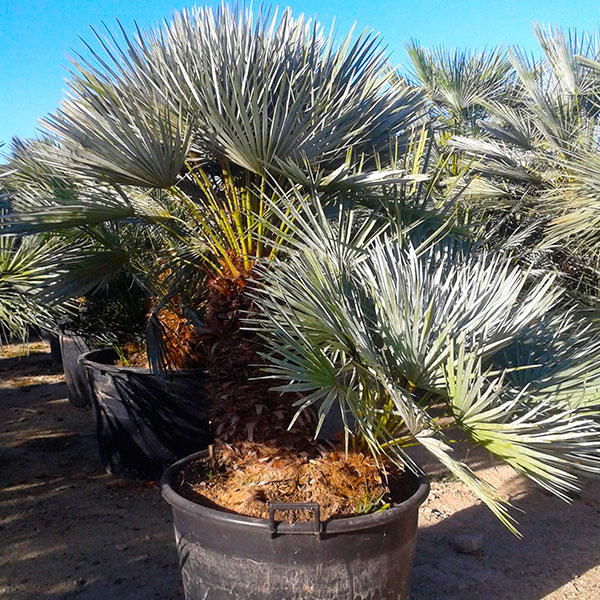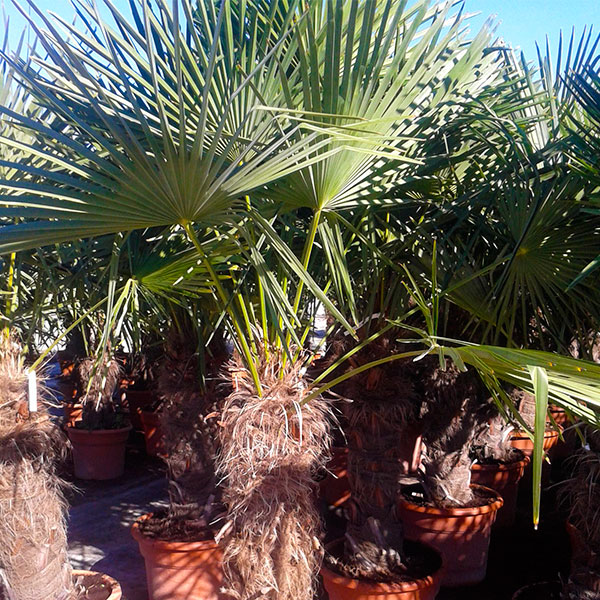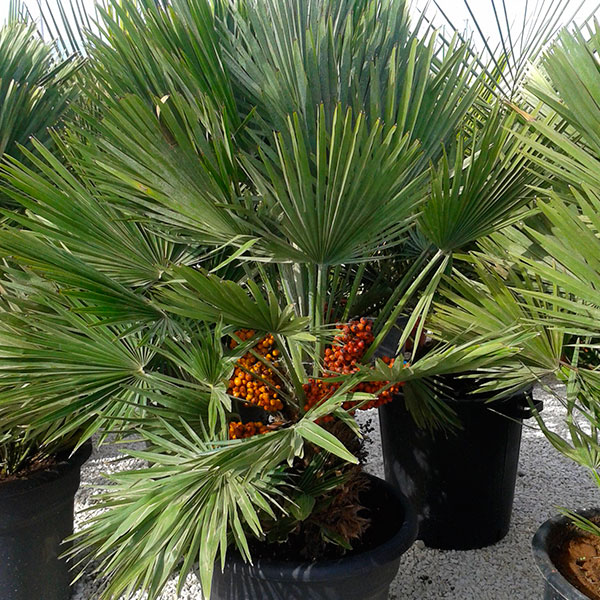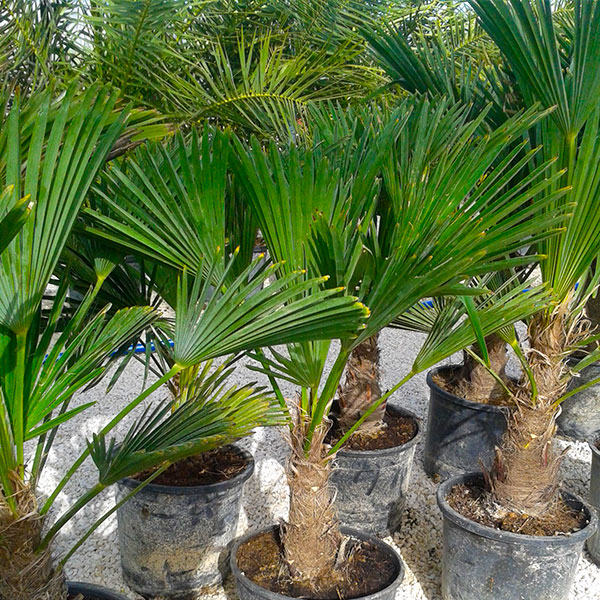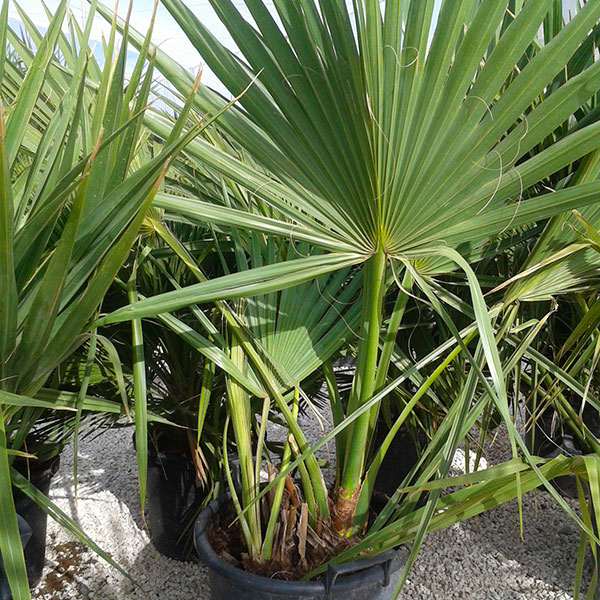
Also present the Cycas and Dracaenas in this chapter that are linked with palm trees in the popular spirit but we raise your attention to the fact that not part of the same family.
A little vocabulary: La Palmera is not a tree, his “trunk” is a stipe, it is an adjustment of leathery leaf sheaths, the surface of the stipe is characterized by the impressions left by the base of the dead “branches”. These “branches” are palms.
Select
In our fields, we select our Palmeras depending on its phytosanitary status, its port, its strength, its stipe, length and number of palms.
Tall palm trees and palms with long fragile, even more impressive, suffered a forced growth that weakens the long term. Under palm trees we grow our best to present conditions only top quality plants. Are regularly checked, we are fighting a biological way against major parasites such as Rhynchophorus ferrugineus and Paysandisia Archon. We guarantee all our plants with a plant passport.
Geographic origin
Our palms are resulting from a regional culture. Most are in the region of Alicante, more rare species are imported from abroad.
Our support culture is a mixture composed of peat (for water retention), mulching (for organic matter) light topsoil (for good fixation of rootlets) and coir.
We supply our palms as a well-developed root system, so, once in place in your garden, the plants raizaran for several years.
Thus, we guarantee the best opportunities for resumptions of palms in addition to its aesthetic quality and brilliant health.
Brahea armata or Mexico blue palm
Negative resists temperatures up to -12 °. His Stipe includes traces of fibrous leaf scars and his palms are broad greenish blue fans. It has an elegant format, is an ideal plant to be installed in the middle of a lawn or a patio. Its growth is very slow.
Butia capitata
Negative resists temperatures up to -15 °. It is very decorative, undemanding as to the nature of the soil and average size.
Chamaerops cerifera or blue dwarf palm
Negative resists temperatures up to -15 °. His palms are covered with a waxy film that gives a very nice blue color of money. Very robust, has the sun, in the shade, resists the wind and cold. Their average size actually a theme very suitable for growing in planters pots and small gardens.
Chamaerops excelsa
The inevitable! The hardier and that harder, Palm supports -18 °. This palm is particularly interesting because of its decorative effect, its hardiness and its undemanding.
Chamaerops humilis
Negative resists temperatures up to -15 °. Pushes tufted, his palms are dark green. Undemanding on the nature of the soil, is used in the ground or container.
Chamaerops vulcano
Negative resists temperatures up to -18 °. Its very compact port gives an effective natural protection against the cold. small gardens Fits very well. It is also very resistant to drought and wind.
Cycas revoluta
Withstands temperatures reaching negative -8 °. The cycas is not a palm but there. It has a very slow growth, a sturdy trunk. Its foliage is dark green, arranged in rosette.
Draceana indivisa, red et variegata
Negative resists temperatures up to -12 °. Undivided variety is clearly green medium green, variety “red” is red bronze, “variegata” variety marginé white cream.
Jubea chilensis or Chile palm
Negative resists temperatures up to -18 °. It is one of the hardiest palm trees but is very rare, its growth is very slow. The leaves are pinnate, of inebriated coloration.
Phoenix canariensis
Withstands temperatures reaching negative -8 °. Has a strong decorative power, it gives itself a major interest to the garden.
El Rhapidophyllum Hystrix
Negative resists temperatures up to -25 ° .Est a thick palm tree with dark green leaves. Its originality and its strength makes it essential for all the collector. Its growth is particularly slow. In their natural environment, this small palm grows in the humid scrubland.
Sabal texana
Withstands temperatures ranging negative to -12 °. It has a gray trunk closely linked rings and large clear sun and green palms dark green shade. The palms can grow up to 15 m.
Washingtonia
Withstands temperatures reaching negative -8 °. You can make 25m summit. It is a very elegant palm whose size and scope of its leaves give an impression of prestige. Its growth is quite fast.
Symbols
Palm “tamar” in Hebrew, which means beauty, thin, thin and also “signal of the brand” is said. Indeed, to survive you will search the water depth or satisfied with brackish or bitter water to give fruit of a great softness.
De l’amertume Nait the douceur …
Palm also means victory, the popularity and triumph over death. Since ancient palm is assigned to the myth of the sun to mention the glory and immortality, because of the harmonious arrangement of its branches and leaves similar to lightning. The palm branch may be an emblem of victory or a sign of good omen. A Roman legend says that Rhea Silvia saw in a dream to Romulus and Remus before he left, under the guise of majestic palm trees.
Some rules
Palm needs a floor to keep the umedad but not the pond. It is essential to put in the bottom of the planting hole or container a layer of gravel.
You can plant all year.
For a year, proportional to the size of your palm and adapted to ambient heat, regular watering is the condition Sinequanone in his good time. It is necessary instead to ensure that the roots do not drown in standing water, especially in autumn and winter.
La Palmera does not require size. In an aesthetic concern, you can cut as dry palms. It is necessary to avoid cutting the terminal bud.
So it is possible to “smooth” the surface of the stem, using a miter saw on the basis Stipe and tracing, in addition to the aesthetic appearance, it has a sanitary interest, since natural crevices can accumulate debris and moisture and then harbor insects .
Like most plants, palm trees can suffer from lack of water, excess water or faults in trace elements if do not have enough credits.
Shopping
In short, when you buy a palm note:
- Variety and its resistance to cold
- State of rootedness.
- Check the quality of its support of culture (or too poor, or too rich or too heavy nor too light).
- Request the plant passport seller.
- Check that Stipe is quite broad, that the palms are not too long and dense enough, and the container is proportional to the size of the palm tree.
The success of our work is the pleasure you have to admire your Palm!



